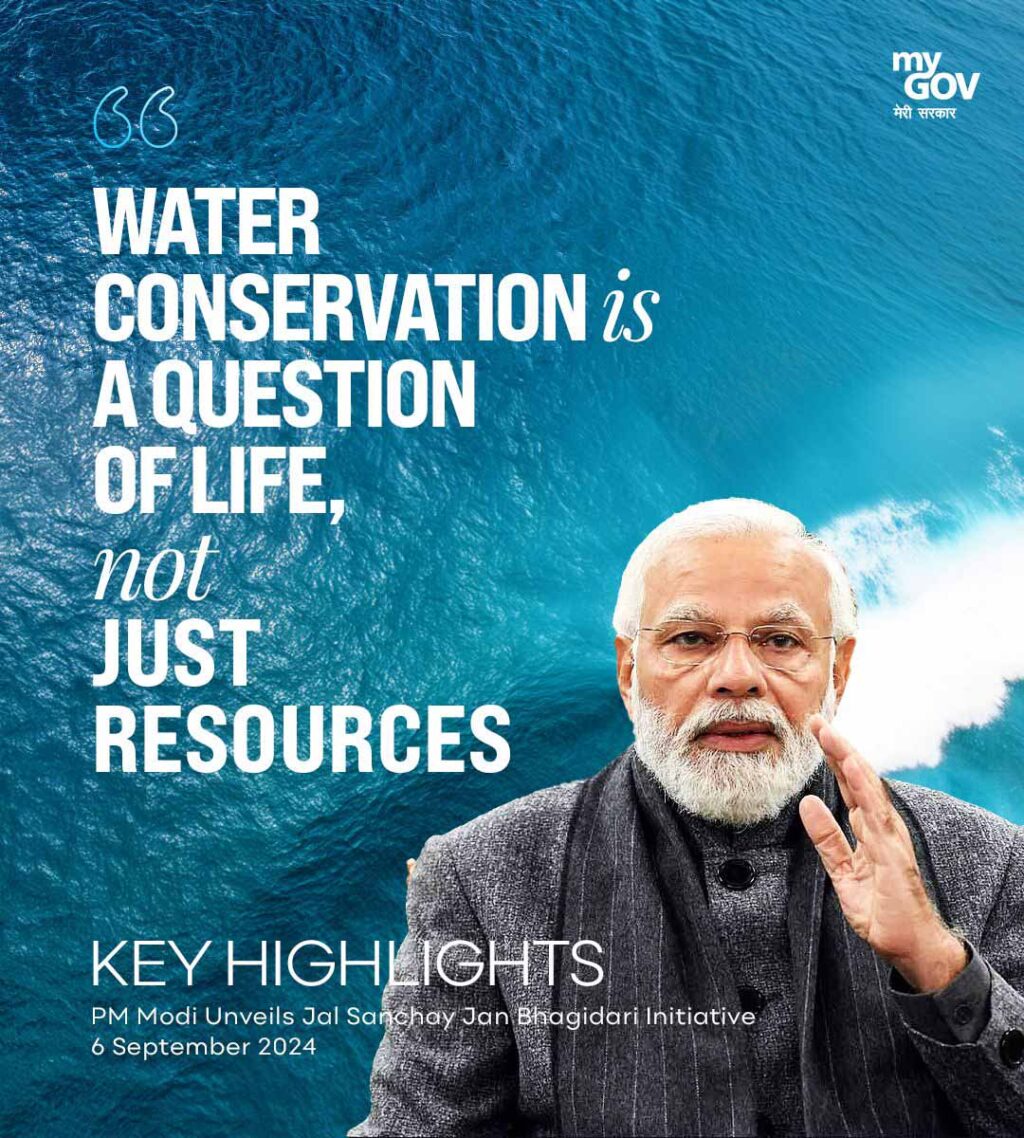PM Modi launched Jal Sanchay Jan Bhagidari initiative in Surat

Surat, Chief Minister of Gujarat, Shri Bhupendrabhai Patel, my colleagues in the Union Council of Ministers, C. R. Patil and Nimuben, ministers of the Gujarat government, MPs, MLAs, District Magistrates, Collectors from all districts of the country, other esteemed guests, and my dear brothers and sisters!
Today, an important initiative is being launched by the Ministry of Jal Shakti from the land of Gujarat. Before that, the widespread rainfall in recent days across every corner of the country has been unprecedented. There is hardly any region in the country that hasn’t been affected by this calamity. I served as the Chief Minister of Gujarat for many years, but I had never heard or seen such intense rainfall across so many talukas simultaneously.
PM Shri @narendramodi ji launches Jal Sanchay Jan Bhagidari initiative.
— Kaushal Dave (@ikaushaldave) September 6, 2024
However, Gujarat faced a significant crisis this time. Our systems were not strong enough to withstand the fury of nature. But the people of Gujarat, and indeed the people of our country, have a nature and capability to come together and support each other in times of crisis. Even today, many parts of the country are facing problems due to severe rainfall.
‘Jal Sanchay’ (water conservation) is not just a policy. It is also an effort, and one might even say it is a virtue. It involves both generosity and responsibility. When future generations assess us, our attitude towards water will likely be one of their primary parameters. This is not just a question of resources; it is a question of life; it is a question of the future of humanity. Therefore, among the nine resolutions we have presented for a sustainable future, water conservation is the first resolution. I am pleased that another meaningful effort in this direction is beginning today through ‘Jan Bhagidari’ (public participation). On this occasion, I extend my best wishes to the Ministry of Jal Shakti of the Government of Bharat, the Gujarat government, and all the people of the country participating in this initiative.
માનનીય વડાપ્રધાન શ્રી નરેન્દ્રભાઇ મોદીએ જળસંચય માટે જનભાગીદારી દ્વારા એક વધુ સાર્થક પ્રયાસની શરૂઆત માટે ખુશી વ્યક્ત કરતાં જાગરૂક જનમાનસ, જનભાગીદારી અને જનઆંદોલનને આ અભિયાનની સૌથી મોટી તાકાત ગણાવી હતી. તેમણે સસ્ટેનેબલ ફ્યુચર માટે જળસંચયના મહત્ત્વને સમજાવતાં જળ સંરક્ષણ અને પ્રકૃતિ… pic.twitter.com/SjwVqOOLtk
— CMO Gujarat (@CMOGuj) September 6, 2024
When we talk about environmental and water conservation, we must always keep several realties in mind. Bharat holds only 4 percent of the world’s fresh water. Our people of Gujarat should understand that this is only 4 percent. Despite the presence of many large rivers in Bharat, a significant part of the country is grappling with water shortage. Water levels are continuously falling in many places. Climate change is deepening this crisis.
And friends,
Despite all this, it is Bharat that has the potential to find solutions to these challenges not only for itself but for the entire world. This is due to the ancient tradition of knowledge in Bharat. Water conservation and nature preservation are not new concepts for us; they are not just theoretical knowledge. These issues are not something that have come to us due to circumstances. They are part of Bharat’s cultural consciousness. We belong to a culture that has revered water as a divine entity and considered rivers as goddesses. ‘Sarovars’ (lakes) and ‘kunds’ (ponds) have been accorded the status of temples. The Ganges is our mother; the Narmada is our mother. The Godavari and the Kaveri are our mothers. This relationship spans thousands of years. Even thousands of years ago, our ancestors understood the importance of water and water conservation. Our ancient scriptures say: “अद्भिः सर्वाणि भूतानि, जीवन्ति प्रभवन्ति च। तस्मात् सर्वेषु दानेषु, तयोदानं विशिष्यते॥”, meaning all beings are born of water and live by it. Therefore, donating water, saving water for others, is the greatest donation. This was also emphasised by Rahim Das centuries ago. We all have read it. Rahim Das said: “रहिमन पानी राखिए, बिन पानी सब सून!”, meaning we should conserve water; without water, everything is barren. A nation with such far-sighted and comprehensive thinking must stand at the forefront of the world in finding solutions to the water crisis.
Friends,
Today’s program is starting on the land of Gujarat, where many successful experiments in delivering and conserving water to every citizen have taken place. We all are aware of the conditions in Saurashtra and North Gujarat until two or three decades ago. The previous governments lacked vision regarding water conservation. That’s why I resolved to prove to the world that a solution to the water crisis is possible. I completed the long-pending Sardar Sarovar Dam project. The Sauni project was started in Gujarat. Water was transferred from areas with surplus water to regions facing water scarcity. Even opposition members mocked us, saying that the pipes being laid would only carry air, not water. But today, the results of the efforts in Gujarat are visible to the entire world. Gujarat’s success and my experiences in Gujarat reassure me that we can rid the country of the water crisis.
Friends,
Water conservation is not just a matter of policies but also of social commitment. ‘Jagruk Janmanas’ (awareness among the public), ‘Jan Bhagidari’ (public participation), and ‘Jan Andolan’ (mass movement) are the greatest strengths of this initiative. You would recall that there were numerous schemes worth thousands of crores of rupees related to water and rivers for decades. But it is only in the last 10 years that we have seen concrete results. Our government has worked with a whole-of-society and whole-of-government approach. Look at all the major schemes over the past 10 years. For the first time, silos related to water issues were broken. We created a separate Ministry of Jal Shakti with a commitment from the whole government. For the first time, the country has taken the pledge of ‘Har Ghar Jal’ (water to every home) through the Jal Jeevan Mission. Previously, only 3 crore households in the country received piped water. Today, over 15 crore rural households are getting piped water. Through the Jal Jeevan Mission, clean water has reached over 75 percent of households in the country. Local ‘Jal Samitis’ (water committees) are now handling the responsibilities of the Jal Jeevan Mission. And just as women excelled in ‘Jal Samitis’ in Gujarat, women are now performing exceptionally well in ‘Jal Samitis’ across the country. At least 50 percent of the participants in these committees are village women.
Brothers and sisters,
Today, the Jal Shakti campaign has become a national mission. Whether it is the renovation of traditional water sources or the construction of new structures, everyone is involved from stakeholders to civil society and panchayats. We also began the work of creating Amrit Sarovars in every district during the Amrit Mahotsav of Independence through Jan Bhagidari. Under this initiative, more than 60,000 Amrit Sarovars have been created across the country through Jan Bhagidari. You can imagine how significant this is for future generations of our country. Similarly, we have started the Atal Bhujal Yojana for groundwater recharge. In this scheme, the responsibility of managing water sources has been given to the people in villages. In 2021, we launched the ‘Catch the Rain’ campaign. Today, people from cities to villages are increasingly participating in ‘Catch the Rain’ campaign. The ‘Namami Gange’ scheme is another example. ‘Namami Gange’ has become an emotional pledge for millions of Indians. People are abandoning superstitions and changing irrelevant practices to make our rivers clean.
Friends,
You all know that I have appealed to the people of the country for ‘Ek Ped Maa Ke Naam’ for the environment. When trees are planted, groundwater levels rise rapidly. In the past few weeks alone, millions of trees have been planted across the country in the name of mothers. There are many such campaigns, many such pledges, and today these are becoming public movements with the participation of 140 crore citizens.
Friends,
We need to focus on the principles of reduce, reuse, recharge, and recycle for water conservation. In other words, water will be saved when we prevent its misuse—reduce its consumption. We need to reuse water, recharge water sources, and recycle polluted water. To achieve this, we need to adopt new methods. We need to be innovative and use technology. We all know that 80 percent of our water needs are for agricultural purposes. Therefore, our government is continuously promoting technologies like drip irrigation in the direction of sustainable agriculture. Campaigns like ‘Per Drop More Crop’ are saving water and increasing farmers’ incomes in low-water areas. The government is also encouraging the cultivation of water-efficient crops like pulses, oilseeds, and millets. Some states are providing incentives to farmers for alternative crops for water conservation. I urge all states to come together to accelerate these efforts and work in mission mode. We need to build ponds and reservoirs near fields and promote traditional knowledge along with new technologies for water recharge.
Friends,
The availability of clean water and the success of water conservation are linked to a significant water economy. For instance, the Jal Jeevan Mission has provided lakhs of people with employment and self-employment opportunities. A large number of jobs have been created for engineers, plumbers, electricians, and managers. According to WHO, providing piped water to every household will save nearly 5.5 crore hours for the people of the country. This time which will be saved, particularly for our sisters and daughters, will directly contribute to boosting the nation’s economy. One important aspect of the water economy is health—well-being. Reports indicate that the Jal Jeevan Mission can prevent the untimely deaths of over 125,000 children. We will also be able to protect over 400,000 people each year from diseases like diarrhea, which means we will be able to reduce expenses on medical care.
Friends,
A significant contribution to this ‘Jan Bhagidari’ mission comes from our industrial sector as well. Today, I would like to thank those industries that have met net zero liquid discharge standards and water recycling goals. Many industries have initiated water conservation efforts as part of their corporate social responsibilities (CSR). Gujarat has set a new benchmark by utilizing CSR for water conservation. I have been informed that about 10,000 borewell recharge structures have been completed with the help of CSR initiatives in Surat, Valsad, Dang, Tapi and Navsari. Now, the Ministry of Jal Shakti and the Gujarat Government have jointly launched a campaign to create an additional 24,000 such structures under the ‘Jal Sanchay-Jan Bhagidari Abhiyan’. This campaign itself is a model that will inspire other states to undertake similar efforts in the future. I hope that together we will make Bharat a beacon of inspiration for water conservation for all of humanity. With this confidence, I extend my best wishes to all of you for the success of this campaign.




